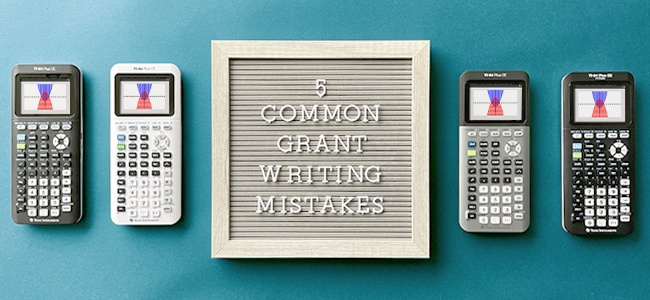How To Avoid 5 Common Grant Writing Mistakes

Grant writing can be a daunting task to undertake, especially for the uninitiated and even more so for educators whose plates are already full. But think of grant proposals as really nothing more than fancier lesson plans or unit plans where the activities and milestones are all mapped out.
Many factors go into writing a successful proposal, but remembering these five common mistakes and knowing what questions to ask yourself can help make things go a bit smoother. Let’s countdown the top five mistakes.


Mistake #5: Ignoring the importance of impact and sustainability
Educators tend to think only about their current group of students, but funders want the biggest bang for their buck. A proposal that only impacts your target audience today won’t be seen as good of an investment as one that will affect future participants, or possibly even members of the community at large.
A successful proposal will include volunteers and resources from the community — ones that not only expand the impact of the grant and bring relevancy to grant activities, but also extend grant dollars through matching which builds in project longevity and sustainability.
Here are some key questions grant writers should ask:
- How many students will my project impact immediately?
- How many students will be impacted over time? How often?
- How can I involve the community at large in my project?
- What matching funds or resources can I incorporate into my budget narrative?
- How will this project continue when the specific grant funding is gone?


Mistake #4: Focusing on the wrong needs
A pitfall for many grant writers is incorrectly identifying the need they want the funder to address. It tends to happen in one of two ways … the first is submitting a proposal that falls outside the funder’s scope or interest. (Know your audience!)
The second way happens when educators focus on their own needs rather than what their target audience’s needs. A typical example is a teacher writing a proposal to fund a classroom set of graphing calculators. That’s the teacher’s need.
The proposal should instead address student learning needs where calculators form just one portion of the solution. Classroom calculators should not be the end goal, but one of many tools and resources to increase student achievement overall or within a targeted area.
To avoid this pitfall, you should ask yourself:
- What is the funder interested in funding?
- What does my target audience need?
- Can I tailor my proposal to hit that sweet spot between meeting my own need, the funder’s interests and the needs of my target audience?
- What evidence do I have to support the identified need?
- How will fulfilling what I want address my target audience’s condition(s)?
- Is there evidence to support the solution I am proposing?


Mistake #3: Thinking too small or too narrowly
Let’s be honest … teachers are experts in knowing how to do more with less. This really plays out when writing grant proposals. Because of this, teachers tend to think too small and limit their ask to the least amount when they should be going for the full monty.
You need to allow yourself to dream big yet spend intentionally.
Frugality is good, but always give yourself room to be innovative and to submit a robust program that brings about real change.
To get in the right mindset, ask the following questions:
- What do I need for the project to be successful?
- Should I include others to enlarge the project’s impact yet make it more manageable because of collaborators?
- Are there additional tools, resources or services needed?
- Have I broadened the scope of my project enough that I can find funders?


Mistake #2: Not following instructions
There are so many adages about following instructions that it’s become a meme. In the grant writing world, it can be the difference between being awarded or having your proposal tossed in the trash! This is especially true for competitive grants.
The fastest way for funders to reduce the number of applications they review is to eliminate the ones that didn’t follow instructions.
Obvious errors on smaller grants can include not following basic directions like what font type to use, word limits, line spacing, margins and page or section limitations.
The more critical mistakes are not paying attention to any legal instructions. Large grants often come with terms and conditions awardees must follow if awarded, but even small awards can have conditions such as who pays the taxes on the funding. So before submitting your proposal, read everything and follow any and all instructions.


Mistake #1: Not applying!
Whether the excuse is "it’s too much work," or "I don't have enough time," or "I'm not qualified," the worst mistake educators can make is to not apply for grants in the first place.
It may go without saying, but if you don’t apply it’s impossible to win. Although you may get denied at first, keep in mind you’ll always receive reviewer comments that can help you improve your proposal for the next round. What’s more, you can even take your revised proposal and submit it to other funders. (Keeping in mind to remember mistake #2, follow directions, and make tweaks as needed.)
Basically, There's no excuse for not writing a grant.
When it’s all said and done, it never hurts to try. You’ll learn, grow and gain from the experience every time you do — so don’t stop until you land yourself that grant!

If you’re interested in learning more about all the moving parts involved with writing grant proposals, check out this free three-part webinar series on demand:
- Grant Writing Part One: Overview of Grants and Funding Sources
- Grant Writing Part Two: Writing a Statement of Need
- Grant Writing Part Three: Developing a Budget
If you thought these tips were helpful, you’ll love our grant writing support resources. For help on your next proposal, visit education.ti.com/grantwriting.
About the author: Jennifer Brewer Cezar is a Grant Partnership Consultant for Texas Instruments. For over 10 years, she has helped to provide funding and grant writing support for schools and districts across the U.S. and Canada. Her work includes identifying valuable opportunities for educators and helping prepare proposals for both small and large grant submissions including GEAR UP.
Tagcloud
Archive
- 2025
- 2024
- 2023
- 2022
-
2021
- January (2)
- February (3)
- March (5)
-
April (7)
- Top Tips for Tackling the SAT® with the TI-84 Plus CE
- Monday Night Calculus With Steve Kokoska and Tom Dick
- Which TI Calculator for the SAT® and Why?
- Top Tips From a Math Teacher for Taking the Online AP® Exam
- Celebrate National Robotics Week With Supervised Teardowns
- How To Use the TI-84 Plus Family of Graphing Calculators To Succeed on the ACT®
- AP® Statistics: 6 Math Functions You Must Know for the TI-84 Plus
- May (1)
- June (3)
- July (2)
- August (5)
- September (2)
-
October (4)
- Transformation Graphing — the Families of Functions Modular Video Series to the Rescue!
- Top 3 Halloween-Themed Classroom Activities
- In Honor of National Chemistry Week, 5 “Organic” Ways to Incorporate TI Technology Into Chemistry Class
- 5 Spook-tacular Ways to Bring the Halloween “Spirits” Into Your Classroom
- November (4)
- December (1)
-
2020
- January (2)
- February (1)
- March (3)
- April (1)
- May (2)
- July (1)
- August (2)
- September (3)
-
October (7)
- Tips for Teachers in the time of COVID-19
- Top 10 Features of TI-84 Plus for Taking the ACT®
- TI Codes Contest Winners Revealed
- Best of Chemistry Activities for the Fall Semester
- Best of Biology Activities for the Fall Semester
- Best of Physics Activities for the Fall Semester
- Best of Middle Grades Science Activities
- November (1)
- December (2)
- 2019
-
2018
- January (1)
- February (5)
- March (4)
- April (5)
- May (4)
- June (4)
- July (4)
- August (4)
- September (5)
-
October (9)
- Art in Chemistry
- Which Texas Instruments (TI) Calculator for the ACT® and Why?
- Meet TI Teacher of the Month: Jessica Kohout
- Innovation in Biology
- Learning With Your Students
- A first-of-its-kind STEM strategy charts path to help educators
- #NCTMregionals Hartford 2018 Recap
- The Math Behind “Going Viral”
- Real-World Applications of Chemistry
-
November (8)
- Testing Tips: Using Calculators on Class Assessments
- Girls in STEM: A Personal Perspective
- 5 Teachers You Should Be Following on Instagram Right Now
- Meet TI Teacher of the Month: Katie England
- End-of-Marking Period Feedback Is a Two-Way Street
- #NCTMregionals Kansas City 2018 Recap
- Slope: It Shouldn’t Just Be a Formula
- Hit a high note exploring the math behind music
- December (5)
- 2017
- 2016
- 2015
